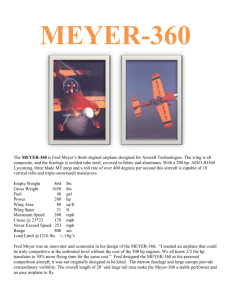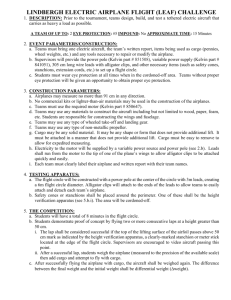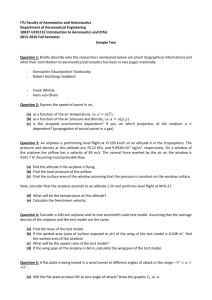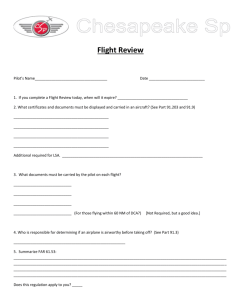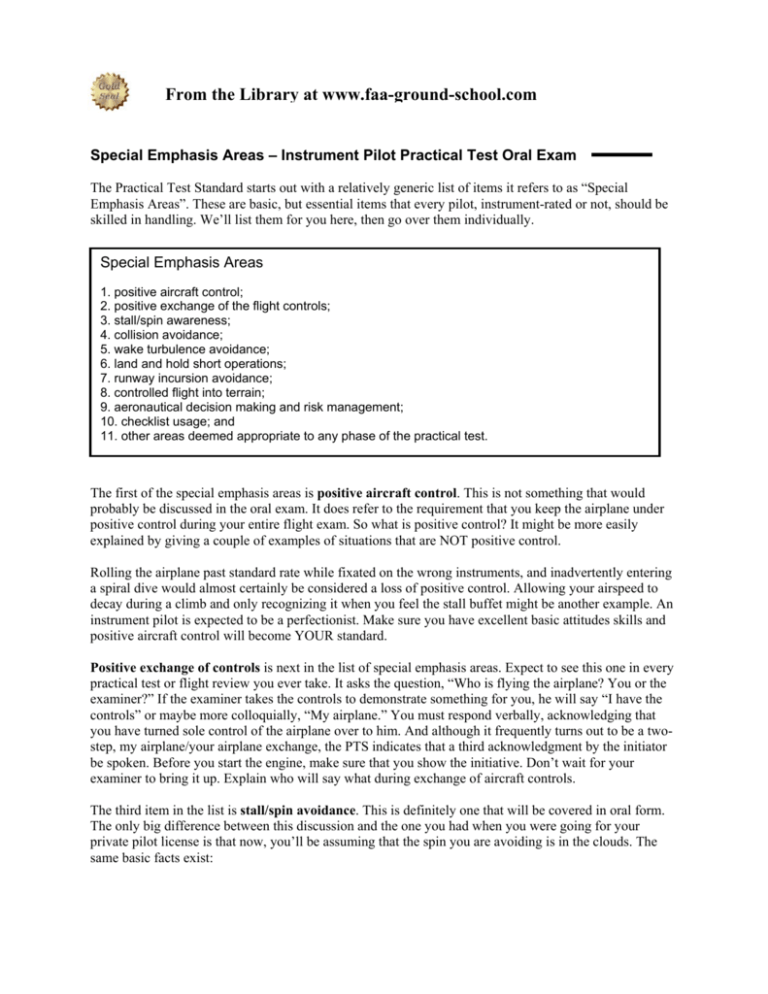
From the Library at www.faa-ground-school.com
Special Emphasis Areas – Instrument Pilot Practical Test Oral Exam
The Practical Test Standard starts out with a relatively generic list of items it refers to as “Special
Emphasis Areas”. These are basic, but essential items that every pilot, instrument-rated or not, should be
skilled in handling. We’ll list them for you here, then go over them individually.
Special Emphasis Areas
1. positive aircraft control;
2. positive exchange of the flight controls;
3. stall/spin awareness;
4. collision avoidance;
5. wake turbulence avoidance;
6. land and hold short operations;
7. runway incursion avoidance;
8. controlled flight into terrain;
9. aeronautical decision making and risk management;
10. checklist usage; and
11. other areas deemed appropriate to any phase of the practical test.
The first of the special emphasis areas is positive aircraft control. This is not something that would
probably be discussed in the oral exam. It does refer to the requirement that you keep the airplane under
positive control during your entire flight exam. So what is positive control? It might be more easily
explained by giving a couple of examples of situations that are NOT positive control.
Rolling the airplane past standard rate while fixated on the wrong instruments, and inadvertently entering
a spiral dive would almost certainly be considered a loss of positive control. Allowing your airspeed to
decay during a climb and only recognizing it when you feel the stall buffet might be another example. An
instrument pilot is expected to be a perfectionist. Make sure you have excellent basic attitudes skills and
positive aircraft control will become YOUR standard.
Positive exchange of controls is next in the list of special emphasis areas. Expect to see this one in every
practical test or flight review you ever take. It asks the question, “Who is flying the airplane? You or the
examiner?” If the examiner takes the controls to demonstrate something for you, he will say “I have the
controls” or maybe more colloquially, “My airplane.” You must respond verbally, acknowledging that
you have turned sole control of the airplane over to him. And although it frequently turns out to be a twostep, my airplane/your airplane exchange, the PTS indicates that a third acknowledgment by the initiator
be spoken. Before you start the engine, make sure that you show the initiative. Don’t wait for your
examiner to bring it up. Explain who will say what during exchange of aircraft controls.
The third item in the list is stall/spin avoidance. This is definitely one that will be covered in oral form.
The only big difference between this discussion and the one you had when you were going for your
private pilot license is that now, you’ll be assuming that the spin you are avoiding is in the clouds. The
same basic facts exist:
An aircraft must be stalled before it can spin.
One wing must be stalled more than the other for an autorotation to develop.
And, an aircraft must remained stalled to remain spinning.
Everyone seems to be able to blurt out “one wing stalled more than the other” during an oral exam, but
frequently don’t understand the dynamics of the resulting autorotation.
The differential in stall amount on each wing also defines a differential in lift from each wing. Remember
that a stalled wing still generates some amount of lift, just not enough to counter the weight of the
airplane.
The low wing in a spin is turning in a smaller radius than the high wing. This creates a differential in
angle of attack - the real cause of the spin. The high, more lift-producing wing continues to try to roll the
airplane. The resulting loss of vertical lift component drops the nose and a twisting, snapping spin is the
nasty outcome.
You know the recovery technique:
Reduce power to idle to limit acceleration;
Neutralize the ailerons;
Apply full opposite rudder to stop (or slow) the turn;
Push forward on the stick or yoke to reduce the angle of attack and break the stall;
Gently recover from the resulting dive.
But spin avoidance is the real objective. Don’t get into the predicament to begin with!
Now most airplanes don’t have any instrument that tells us what angle of attack the wings are
experiencing. That means we have to use the airspeed indicator to infer when we could be approaching a
stall situation. The stall speeds listed in your aircraft handbook assume straight-and-level flight. Bank the
wings and that stall speed goes up.
So there are a lot of reasons to keep your airplane level in the clouds and to limit turns to standard rate.
Shallow bank angles are less conducive to stall/spin conditions. And because of that stall differential
thing, if you’re going to stall the airplane, wings level is the preferable way.
Hopefully, you’ve realized at this point that letting bank angle increase too high while letting the airspeed
creep too low is a recipe for something we already mentioned – loss of positive control of the airplane.
Recovery from a spin in IMC – instrument meteorological conditions – is a stressful affair. You don’t
have any visual indications other than the dials on your panel. Pilot disorientation becomes highly likely.
Airspeed may be stable or oscillating and you’ll probably feel yourself slung around uncomfortably. The
attitude indicator may be spinning or may fail altogether. It probably won’t be clear to you which way the
airplane is turning. But there is one gage that is there to save you – the turn coordinator.
Notice which wing is up and apply rudder to that side. Power to idle, step on the high wing, and push
forward to break the stall. Once the spin has stopped, recover from the resulting dive with a very gentle
pull back into level flight. Do that too abruptly and you’ll simply exceed the critical angle of attack and
stall the airplane all over again.
Stalls and spins in IMC are not something you want to experience. Increase your options and practice
avoidance.
2
Collision avoidance is next on our list. It sounds kind of funny to think about collision avoidance when
you’re flying in zero visibility conditions. But remember that some parts of your flight will be in visual
conditions, even if only briefly. Just because you are flying on an IFR flight plan does not release you
from the requirement to see and avoid traffic. The FAA is very clear about this: If you are in VFR
conditions, regardless of whether or not you are on an IFR flight plan, it is your responsibility to visually
scan for and avoid other aircraft.
Wake turbulence avoidance, number five in the list, should be an obvious issue. It might not be
discussed during an IFR oral exam, but it is something you want to plan for, particularly when taking off
and landing. If you’re number two for takeoff behind a Gulfstream, be prepared to describe for your
examiner how you plan to deal with the possibility of wake turbulence.
LAHSO, or land and hold short operations, is another non-IFR issue that EVERY pilot must be
prepared to deal with. Pilots are not required to accept land and hold short clearances, but honestly, if
you’re uncomfortable with that, you probably need to go back to the books and spend some time with an
instructor practicing short field landings. Don’t go to your checkride without having a thorough
understanding of what LAHSO means.
The FAA has become really hot on runway incursions over the past few years. Again, this is not an IFR
issue. It is one that affects every pilot. Even though it is in the list of Special Emphasis Areas, we won’t
go into a discussion of the topic here. But please make sure that you understand the factors and the
regulations.
Controlled flight into terrain is frequently abbreviated as CFIT. It refers to a situation where a pilot has
been flying along fat and happy and inadvertently collides with Mother Earth because he was unaware of
the local ground elevation. Some old pilots call it flying into cumulogranite.
CFIT is most likely to occur in mountainous terrain. Issues involved include MEAs and MOCAs, as well
as pilot situational awareness. This subject is of particular interest to instrument pilots simply because it is
less likely to occur in visual conditions. The most obvious way to avoid flying from cumulous into
cumulogranite is to be aware of and abide by all published minimum altitudes. Especially during
approaches. Know where you are and where Mother Earth is at all times. That sounds trite, but in areas
where terrain elevations change frequently and quickly, it can become a real challenge.
Aeronautical decision making and risk management are subjective issues. Your examiner will be
constantly evaluating you in this area. He may give you scenarios based on a variety of conditions merely
to see how you sort it all out. According to the PTS:
The examiner shall accomplish this requirement by developing scenarios that incorporate as
many TASKs as possible to evaluate the applicant’s risk management in making safe
aeronautical decisions. For example, the examiner may develop a scenario that incorporates
weather decisions and performance planning.
The applicant’s ability to utilize all the assets available in making a risk analysis to determine
the safest course of action is essential for satisfactory performance.
Oral exams are rarely cut and dried affairs. Your IFR oral will be no exception. Take your time and
consider all the factors. Evaluate what outcome is desired and what must be done to reach that outcome.
And always remember that factors change. In the air, your analysis and decision making will be a
continuing process.
3
Number ten in the Special Emphasis list is checklist usage. Certainly you will use a checklist for your
preflight procedures. But make sure you have it expanded to include preflight checks specific to
instrument flight. Your wet compass must swing freely and be full of fluid. With the correct barometric
pressure entered, your altimeter should register within 75 feet of actual field level. Your attitude indicator
should not bank more than five degrees during taxi turns and may dip down during braking. Your turn
coordinator, a particularly important instrument, should show wings level and a centered ball when the
airplane is sitting still or taxiing in a straight line. During taxi turns, the wings or needle should go one
way, the ball the other. Ensure that your instructor has given you a thorough preflight checklist to use
before going to visit your examiner.
The final item in the Special Emphasis list is a catchall. “Other areas deemed appropriate.” This gives
the examiner a lot of latitude and limits your ability to complain that he was unfair with you. Just because
it isn’t spelled out in the PTS doesn’t mean it might not rightfully come up on your checkride.
The issue of currency is an excellent example. You can count on talking about it during your oral exam.
Aircraft Currency
Along with the annual (and 100-hour if it is a rental airplane) and ELT checks, to be flown under an IFR
flight plan, an airplane must be IFR current. This includes a pitot-static system (including the altimeter)
and transponder check, performed by a licensed technician every 24 months. Be ready to show your
examiner where these entries are in the aircraft logbook.
Navigational Instrument Checks
Your avionics’ ability to accurately read VOR signals must be checked every 30 days. This must be kept
in a log, but not necessarily in the official aircraft logbooks. It can be performed by the pilot. See section
6 for more information on this. Additionally, if IFR-certified GPS is used, the database must be current.
IFR Pilot Currency
Of course you have the requirements to be instrument rated, with a current medical and flight review. But
there are some extra requirements for instrument pilot currency.
In order to fly under IFR, an instrument pilot must be current in terms of approaches, tracking maneuvers,
and holds. Specifically, the pilot must have performed at least six instrument approaches under simulated
or actual instrument conditions within the last six months. He or she must also have performed tracking
maneuvers and holds. While the FARs don’t specify exactly how many holds are required for legal
currency, it is important to note that they use the word in plural form. So, expect a minimum of two holds
for compliance with this requirement.
If the IFR pilot fails to complete his currency requirements within six months, he has an additional six
months to become current. However, he cannot file IFR during this period. Thus, the maneuvers required
to meet the obligation must be either in VMC with a safety pilot aboard, or under the instruction of a CFI.
If this second six-month period lapses without compliance, the pilot must undergo an Instrument
Proficiency Check with an examiner or CFII.
Copyright 2006 by Atlanta Flight, Inc. All Rights Reserved.
4



